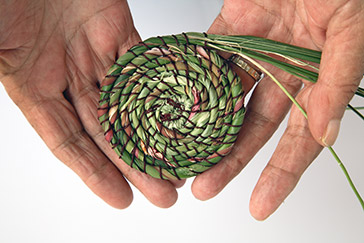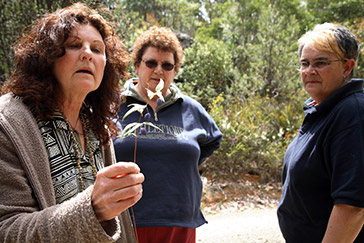
In November 2006, the second tayenebe workshop was held north of Bicheno on the East Coast of Tasmania.
The number of participants grew from six to eleven women, newcomers included weavers Gloria Andrews, Patsy Cameron, Audrey Frost, Aunty Muriel Maynard (dec), Nannette Shaw and Dyan Summers.
Spring is when the Diplarrena moraea or white flag iris is in flower. The women discovered few plants were readily available within close proximity of the workshop, and took the advice of horticulturalist Paul Frater to collect from the nearby hillside above St Marys.
The first participants to arrive set off early the following morning to walk and collect plant leaves including Lomandra longifolia, commonly known as sagg or mat rush, and Juncus pallidus. Few of the women had worked with these grasses before, preferring to use the leaves of more familiar but introduced New Zealand flax, red hot poker and cordyline or cabbage palm and cumbungi plants.
‘I like to collect my plants from out in the bush, collect them myself. Not necessarily seasonally. I find it’s not a problem to find plants all the year round. You might know a special gully where the leaves grow really long. That sort of thing.’ Colleen Mundy, Bruny Island, May 2006
Colleen demonstrated the easy steps to starting a basket in the way she was taught by Aunty Lennah Newson.
The following morning, local East-Coast woman Gloria Andrews took the women collecting plants in an area just off the main road to St Helens. The women discovered a plant growing quite close by, under a Banksia tree, commonly known as sweet rush. The majority of the weavers found the leaves easy to split and weave and many of the women wove a range of samples. One outcome of this workshop was an increased awareness of where local plants were growing but few weavers were keen to twine the native plant fibres as they thought it was slow and fiddley.


Photographer: Lucia Rossi